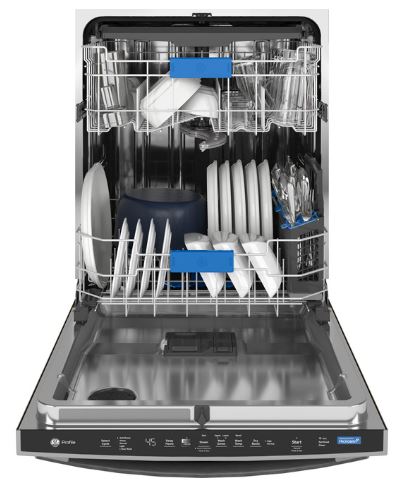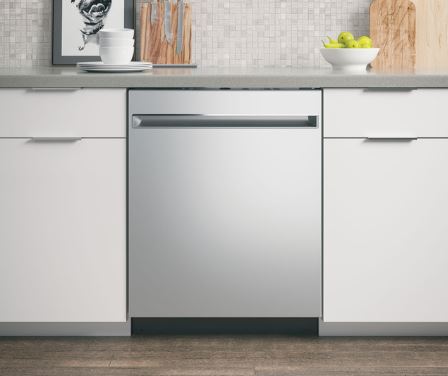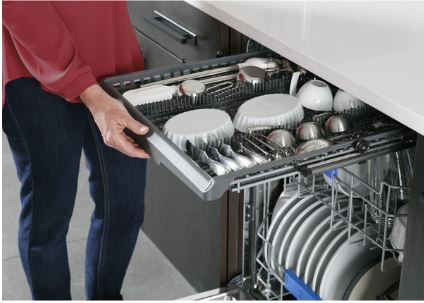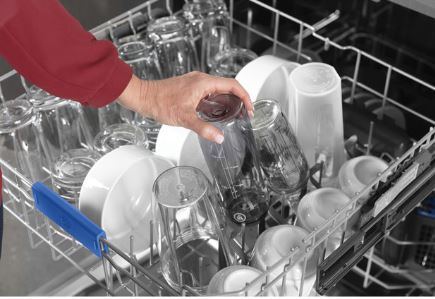Have you been wondering why your GE dishwasher fills with water then stops? Have you tried checking out the dishwasher to no avail and are planning to call a dishwasher expert? Well, don’t just yet!
Your GE dishwasher fills with water and stops due to a water supply, drainage, water inlet valve, door switch, drive belt, pump impeller, circulation motor, drain solenoid, float assembly, or control board fault.
If any of those ten issues touches on your dishwasher, you can be sure that the dishwasher won’t fill up to completion. And if it doesn’t fill up, it won’t wash the dishes, and that’s a worrying concern.
What’s not worrying, however, is its troubleshooting, as you can fix most of these issues, and I’ll show you how. We’ll discuss not just the 10 cases but also their applicable fixes. So, let’s dive in!

In a hurry? Consider the quick guide below if your GE dishwasher fills with water briefly and stops:
GE Dishwasher Fills with Water Then Stops – Quick Fixes
| – | Likely Cause | Quick Fix |
| 1. | Water Supply Fault | Ensure the water supply is on, straighten out any kinks, and call a plumber in case of low water pressure. |
| 2. | Drainage Fault | Unclog the drain filter and hose if they are obstructed. |
| 3. | Water Inlet Valve Fault | Replace the inlet valve if it’s clogged or fails the multimeter continuity quick check. |
| 4. | Door Switch Fault | Replace the door switch if it fails the multimeter continuity quick check. |
| 5. | Drive Belt Fault | Replace a damaged drive belt. |
| 6. | Pump Impeller Fault | Clear any obstruction from the impeller. If the blades are dented, replace the pump impeller. |
| 7. | Circulation Motor Fault | Replace the circulation motor if it hums loudly or fails the continuity test. |
| 8. | Drain Solenoid Fault | Check for an error code and look it up, or call a pro. |
| 9. | Float Assembly Fault | Try to unstick the float assembly if it’s stuck and replace it if it’s damaged. |
| 10. | Control Board Fault | Replace the electronic control board as your last resort. |
Why Does My GE Dishwasher Fill with Water Then Stop?
It only takes one fault to stop a GE dishwasher from filling up completely, and below are 10 to consider:
1. Water Supply Fault
You cannot expect your GE dishwasher to fill up with water if there is an issue with the water supply. Remember, it could be that the water supply or tap is off, the inlet hose is blocked, or the water pressure is insufficient.
In any of the three cases, your GE dishwasher won’t get enough water, so it’ll not fill up.
Fix
Check if the water supply is on. Ensure the tap is open, and if there are any pinches or kinks on the inlet hose, straighten the hose to clear them.
Meanwhile, check the other appliances that might be using the water supply at home. If they also have a problem getting water, it could be that the water pressure isn’t enough, and in such a case, call an expert plumber.
2. Drainage Fault
If your GE dishwasher doesn’t drain properly, it may not fill up. In such a case, poor drainage could result from a clogged drain filter or drain hose. But still, the drain hose could be kinked. Hence, consider all the possibilities.
Fix
If the drain filter is clogged, wash it thoroughly with soap and water, and if the drain hose is obstructed, dislodge the blockade using a thin wire or vacuum. But if there are kinks on the drain hose, only straighten the pipe out to remove them.

3. Water Inlet Valve Fault
The inlet valve lets water flow into the dishwasher. That naturally happens when it’s neither clogged nor damaged. However, once that’s the case and the inlet valve is faulty, it stops the dishwasher from filling up.
Fix
Inspect the water inlet valve for clogging or damage. Testing it with a multimeter can also tell if it’s defective. The absence of continuity confirms it’s faulty and needs a replacement.
4. Door Switch Fault
A problem with the door switch will prevent the dishwasher door from latching firmly. Once the dishwasher sensors sense that the door is not firmly shut, they may force the dishwasher into an automatic shutoff, which means it won’t continue filling up with water.
Fix
Check the door switch with a multimeter. If it fails to show continuity, replace it. That confirms it’s faulty.
5. Drive Belt Fault
Regarding older GE dishwashers, the water-filling process also depends on a working drive belt. If the drive belt is defective, the dishwasher may fail to fill up, and if it does start, it won’t complete the fill-up process.
Overall, this should only be a consideration if you have an older GE dishwasher.
Fix
Inspect the dishwasher belt for damage or wear and replace it if that’s the case.
6. Pump Impeller Fault
If there’s an issue with the pump impeller, it’ll affect the water-filling process. For example, if the impeller is clogged, it’ll stop the water from flowing through to the inlet, and if the impeller blades are damaged, the impeller will fail to regulate water flow.
Fix
Inspect the impeller for clogging and unclog it. Replace it, however, if the blades are broken.
7. Circulation Motor Fault
You expect the circulation pump to pump water around the dishwasher. However, it doesn’t do so if it’s stuck (following long-term dormancy) or damaged.
Overall, you can tell you have a defective circulation pump if the dishwasher produces a humming sound while trying to run.
Fix
Replace the circulation motor if you identify the loud humming noise. You can, however, have a more conclusive diagnosis by testing the pump’s terminals with a multimeter. If they fail to show continuity, then the pump is defective.

8. Drain Solenoid Fault
Another component worth checking is the dishwasher’s solenoid. If the drain solenoid is broken, burnt, or non-operational, the drain valve won’t open, stopping the dishwasher from commencing the drain cycle. And remember, if the dishwasher doesn’t drain, it doesn’t fill up.
Fix
Ordinarily, the dishwasher will display an error code when the drain solenoid is faulty. So, note down any error code on your Whirlpool dishwasher and look it up. If there’s no error code, call a pro.
9. Float Assembly Fault
The float assembly is a small device at the bottom of your GE dishwasher tub that controls the fill-up process. If it’s stuck, it misleads the dishwasher into thinking that the tub has excess water and forces it into a self-shut. So, the dishwasher won’t continue filling up with water.
Fix
If the float assembly is stuck, try to remove any dirt obstruction to release it. However, replace it if it’s damaged.
10. Control Board Fault
Lastly, it could be that the control board of your GE dishwasher is defective, and that’s why the dishwasher aborts the water fill-up process midway. That’s expected since the control board controls every other dishwasher function, not just the water fill-up process.
GE Dishwasher Won’t Stop Filling with Water
Sometimes, a GE dishwasher will continue filling up with water even after having enough. That’s not normal. It points to a fault, and it could be any of the following:
- The water inlet valve could be malfunctioning
- The float switch might be defective
- Potentially low water pressure
- Potentially faulty water-level switch which won’t tell the dishwasher when to stop filling
GE Dishwasher Fills with Water but Does Not Wash
While you expect your GE dishwasher to start washing the dishes once it fills up with water, sometimes it doesn’t. That may happen due to clogged spray arms, a motor malfunction, or a defective printed circuit board.
If the spray arms are clogged, clean them, and if the motor is humming loudly, replace it. However, replacing the printed circuit board is the last option, especially if it shows signs of burning or damage.
My GE Dishwasher Won’t Fill with Water
If your GE dishwasher won’t fill up with water, it could be due to one of these reasons:
- Clogged drain filters
- Kinked drain hose
- Closed or blocked water supply line
- Faulty circulation pump motor
- Stuck float switch
- Faulty door switch which stops the dishwasher door from firmly latching

GE Dishwasher Fills with Water When Off
It’s abnormal for a dishwasher to continue filling up with water while it’s off. That, however, may happen to the GE dishwasher in some cases.
For example, a GE dishwasher may continue filling up while off due to a drain water backflow (because of poor drainage), a water inlet valve malfunction, an incorrectly fitted drain hose, or a defective check valve, impeller, or float switch.
People Also Ask
1. Why Does My GE Dishwasher Start and Then Stop?
Your GE dishwasher starts and then stops due to a malfunctioning sensor, a drainage problem, or a defective belt. If that’s not it, it could be a motor fault or inadequate water supply. In the latter case, ensure your dishwasher receives adequate water.
2. Why Is My Dishwasher Filling But Not Starting the Wash Cycle?
Your dishwasher might fill with water but fail to start the wash cycle. That may happen due to a motor fault, clogged spray arms, or a defective printed circuit board.
You can tell if the motor is at fault if the dishwasher is humming very loud, and of course, a visual examination will show you a possibly clogged spray arm. As for the circuit board, you can inspect it for damage or burns and replace it.
3. How Do I Reset My GE Dishwasher?
You can reset your GE dishwasher by pressing the reset button, which you can locate on the control panel, behind its kick plate, or at the bottom of the dishwasher. If you can’t find the reset button, consider plugging out the dishwasher for about 5 minutes, plug it back in, and restart it.
Concluding Thought:
Above are the ten reasons a GE dishwasher fills with water then stops. One reason is all it takes to stop your dishwasher from filling up and washing the dishes.
As a recap, it could be an issue with the water supply, drainage, water inlet valve, door switch, drive belt, pump impeller, circulation motor, drain solenoid, float assembly, or dishwasher control board.
Whatever it is, it’s fixable, and even if you can’t fix it, you can ask for a dishwasher expert’s help.
